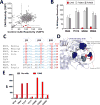Immunization-Elicited Broadly Protective Antibody Reveals Ebolavirus Fusion Loop as a Site of Vulnerability
- PMID: 28525756
- PMCID: PMC5803079
- DOI: 10.1016/j.cell.2017.04.038
Immunization-Elicited Broadly Protective Antibody Reveals Ebolavirus Fusion Loop as a Site of Vulnerability
Abstract
While neutralizing antibodies are highly effective against ebolavirus infections, current experimental ebolavirus vaccines primarily elicit species-specific antibody responses. Here, we describe an immunization-elicited macaque antibody (CA45) that clamps the internal fusion loop with the N terminus of the ebolavirus glycoproteins (GPs) and potently neutralizes Ebola, Sudan, Bundibugyo, and Reston viruses. CA45, alone or in combination with an antibody that blocks receptor binding, provided full protection against all pathogenic ebolaviruses in mice, guinea pigs, and ferrets. Analysis of memory B cells from the immunized macaque suggests that elicitation of broadly neutralizing antibodies (bNAbs) for ebolaviruses is possible but difficult, potentially due to the rarity of bNAb clones and their precursors. Unexpectedly, germline-reverted CA45, while exhibiting negligible binding to full-length GP, bound a proteolytically remodeled GP with picomolar affinity, suggesting that engineered ebolavirus vaccines could trigger rare bNAb precursors more robustly. These findings have important implications for developing pan-ebolavirus vaccine and immunotherapeutic cocktails.
Copyright © 2017 Elsevier Inc. All rights reserved.
Figures







Comment in
-
Ebolavirus's Foibles.Cell. 2017 May 18;169(5):773-775. doi: 10.1016/j.cell.2017.05.008. Cell. 2017. PMID: 28525748
-
Neutralizing the Threat: Pan-Ebolavirus Antibodies Close the Loop.Trends Mol Med. 2017 Aug;23(8):669-671. doi: 10.1016/j.molmed.2017.06.008. Epub 2017 Jul 8. Trends Mol Med. 2017. PMID: 28697885 Free PMC article.
References
-
- Brannan JM, Froude JW, Prugar LI, Bakken RR, Zak SE, Daye SP, Wilhelmsen CE, Dye JM. Interferon alpha/beta Receptor-Deficient Mice as a Model for Ebola Virus Disease. J Infect Dis 2015 - PubMed
MeSH terms
Substances
Grants and funding
LinkOut - more resources
Full Text Sources
Other Literature Sources
Medical
Molecular Biology Databases

